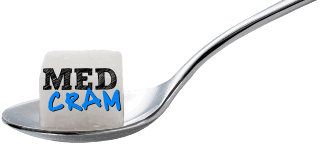In this update video, Roger Seheult, MD of MedCram discusses the vitamin D paradox in Covid-19 and why it can predict but not always protect against disease severity. The question of why low levels of vitamin D are associated with increased severity in Covid-19 but then prospective studies with vitamin D supplementation do not show significant improvement in Covid-19 severity is discussed. In this study, patients with vitamin D levels less than 20 ng/mL were 14 times more likely to have severe or critical disease including mortality than patients whose vitamin D levels were greater than 40 ng/mL. This paper showed that patients’ survival was greatly dependent on vitamin D levels. If levels were less than 12 ng/mL, survival was significantly lower than if they were above 12 ng/mL. The study even raised the value to 20ng/mL of vitamin D levels and this too showed a statistical significance in decreased survival probability for levels under 20 ng/mL.
Vitamin D Research
A video done by MedCram on vitamin D that has received over 12 million views has gone over these and other findings in vitamin D research. Adrian Martineaux did a metaanalysis seen in BMJ in 2017 showing that vitamin D cut the risk of acute respiratory infections. A new current study that has not been peer-reviewed as of yet discusses a randomized controlled trial where they looked at 6200 patients and gave a 3200 IU dose of vitamin D to participants. The participants did have a correction of vitamin D levels to greater than 30 ng/mL; however, despite the elevation in vitamin D levels, it wasn’t associated with protection against all-cause acute respiratory infection or Covid-19. This finding isn’t unique because numerous studies haven’t shown significant improvement in disease severity with prospective vitamin D supplementation.
Dr. Seheult states he takes his vitamin D daily. A video done by MedCram on vitamin D and autoimmune disease showed that vitamin D supplementation reduced autoimmune disease risks prospectively. We are seeing the data that associations with disease severity are worse with low vitamin D levels, but we are not seeing a great of data showing significant improvement with vitamin D supplementation in disease severity. Another video done by MedCram called Light as Medicine explains that there may be more to sunlight than just vitamin D and that what may be needed is sunlight as a whole package rather than just extracting one component of sunlight such as vitamin D.
Sunlight Exposure
Dr. Seheult reiterates again that those people who spend more time outdoors either in direct or indirect sunlight, have increased UV and near-infrared radiation (NIR). There are studies proposing that NIR can lead to increased intracellular melatonin production. Melatonin is an extremely powerful antioxidant, even more so than glutathione. This may be the key to lessening Covid-19 severity. Industrialized countries typically have more people who work indoors, have means and affluence and drive cars and stay in their offices. They will have less exposure to UV light and NIR which will result in lower vitamin D levels and theoretically less production of intracellular melatonin which can lead to more severe Covid-19 symptoms. The US population comprises about 4% of the world population, yet it had 25% of the world’s Covid-19 cases. Dr. Seheult proposes that if it is really intracellular melatonin that is doing the “heavy lifting,” supplementation with vitamin D may not help during the acute phase.
A study in Nature found that latitude In Europe was correlated with Covid-19 surges. It did not find a correlation with temperature or humidity. An observational study in the BJD found that in the US in wintertime, the more sunlight someone got, the more the incidence of Covid-19 death went down. It was proposed that if there is something in the sunlight that is aiding in reducing death rates from Covid-19, then perhaps optimizing sun exposure could be a future public health intervention.
Sunlight as a package
Sunlight itself may be a package deal as we know that besides vitamin D, there are effects from the visible light spectrum on circadian rhythm, mood, pineal melatonin production, and then in the NIR spectrum which is proposed to create intracellular melatonin.
Zimmerman’s study showed that mitochondria make melatonin in quantities that are orders of magnitude higher than that produced in the pineal gland. It suggests that the NIR portion of sunlight stimulates an excess of antioxidants in each of the healthy cells. The majority of energy coming from the sun is in the infrared portion which can penetrate deep into the dermis. Today the amount of NIR radiation we receive as well as generalized sunlight exposure as an industrialized society has been decreasing over the past 100 years. Dr. Seheult advises it would be ideal if we could do studies to gain further information on the importance of sunlight.
LINKS / REFERENCES:
Pre-infection 25-hydroxyvitamin D3 levels and association with severity of COVID-19 illness (PLOS) | https://journals.plos.org/plosone/art…
Vitamin D Supplements for Prevention of Covid-19 or other Acute Respiratory Infections: a Phase 3 Randomized Controlled Trial (medRxiv) | https://www.medrxiv.org/content/10.11…
Sunlight: Optimize Health and Immunity (MedCram) | https://youtu.be/5YV_iKnzDRg
MedCram: Vitamin D and Covid 19: the evidence for prevention and treatment of coronavirus (SARS CoV 2)
MedCram: Vitamin D reduces autoimmune diseases: new research
MedCram: Sunlight: Optimize Health and Immunity (Light Therapy and Melatonin)
Stay Tuned for More COVID-19 Updates
Our COVID-19 videos are always available for free (and ad-free) at MedCram.com. In addition, check out our full library of courses and lectures on subjects ranging from Hypertension Explained Clearly to Sleep Apnea Explained Clearly Course and many more!
Meanwhile, you can find all of our COVID-19 videos compiled here.
